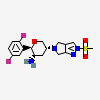Omarigliptin
- OMARIGLIPTIN
- 1226781-44-7
- MK-3102
- (2R,3S,5R)-2-(2,5-DIFLUOROPHENYL)-5-(2-(METHYLSULFONYL)PYRROLO[3,4-C]PYRAZOL-5(2H,4H,6H)-YL)TETRAHYDRO-2H-PYRAN-3-AMINE
- MK3102
- Create:2010-07-06
- Modify:2024-12-28

- 2-(2,5-difluorophenyl)-5-(2-(methylsulfonyl)-2,6-dihydropyrrolo(3,4-c)pyrazol-5(4H)-yl)tetrahydro-2H-pyran-3-amine
- MK-3102
- Omarigliptin
- OMARIGLIPTIN
- 1226781-44-7
- MK-3102
- (2R,3S,5R)-2-(2,5-DIFLUOROPHENYL)-5-(2-(METHYLSULFONYL)PYRROLO[3,4-C]PYRAZOL-5(2H,4H,6H)-YL)TETRAHYDRO-2H-PYRAN-3-AMINE
- MK3102
- Omarigliptin (MK-3102)
- CVP59Q4JE1
- 2H-Pyran-3-amine, 2-(2,5-difluorophenyl)-5-[2,6-dihydro-2-(methylsulfonyl)pyrrolo[3,4-c]pyrazol-5(4H)-yl]tetrahydro-, (2R,3S,5R)-
- UNII-CVP59Q4JE1
- (2R,3S,5R)-2-(2,5-difluorophenyl)-5-(2-(methylsulfonyl)-2,6-dihydropyrrolo[3,4-c]pyrazol-5(4H)-yl)tetrahydro-2H-pyran-3-amine
- (2R,3S,5R)-2-(2,5-difluorophenyl)-5-(2-methylsulfonyl-4,6-dihydropyrrolo[3,4-c]pyrazol-5-yl)oxan-3-amine
- (2R,3S,5R)-2-(2,5-Difluorophenyl)-5-[2-(methylsulfonyl)-2,6-dihydropyrrolo[3,4-c]pyrazol-5(4H)-yl]tetrahydro-2H-pyran-3-amine
- 2H-Pyran-3-amine, 2-(2,5-difluorophenyl)-5-(2,6-dihydro-2-(methylsulfonyl)pyrrolo(3,4-c)pyrazol-5(4H)-yl)tetrahydro-,(2R,3S,5R)-
- Omarigliptin [USAN]
- Omarigliptin [USAN:INN]
- MFCD22573261
- Omarigliptin (Standard)
- MK-3102Omarigliptin?
- OMARIGLIPTIN [MI]
- OMARIGLIPTIN [INN]
- OMARIGLIPTIN [JAN]
- OMARIGLIPTIN [WHO-DD]
- SCHEMBL827590
- GTPL8402
- Omarigliptin (JAN/USAN/INN)
- CHEMBL2105762
- DTXSID70153678
- EX-A395
- CHEBI:134735
- MKMPWKUAHLTIBJ-ISTRZQFTSA-N
- BDBM50003020
- HY-15981R
- NSC802900
- s8565
- AKOS025289528
- CCG-268634
- CS-3948
- DB11992
- DS-7574
- NSC-802900
- PB39113
- NCGC00480770-01
- (2R,3S,5R)-2-(2,5-Difluorophenyl)-5-(2-(methanesulfonyl)-2,6-dihydropyrrolo(3,4- c)pyrazol-5(4H)-yl)oxan-3-amine
- (2R,3S,5R)-2-(2,5-Difluorophenyl)-5-(2-(methylsulfonyl)-2,6-dihydropyrrolo(3,4- c)pyrazol-5(4H)-yl)tetrahydro-2H-pyran-3-amine
- 2H-Pyran-3-amine, 2-(2,5-difluorophenyl)-5-(2,6-dihydro-2-(methylsulfonyl)pyrrolo(3,4- c)pyrazol-5(4H)-yl)tetrahydro-, (2R,3S,5R)-
- AC-28992
- HY-15981
- NS00073001
- D10317
- L10002
- J-690074
- BRD-K14171291-001-01-4
- Q21098979
- (2R,3S,5R)-2-(2,5-Difluorophenyl)-5[2-(methylsulfonyl)-2,6-dihydropyrrolo[3,4-c]pyrazol-5(4H)-yl]tetrahydro-2H-pyran-3-amine

P260, P319, and P501
(The corresponding statement to each P-code can be found at the GHS Classification page.)
Aggregated GHS information provided per 36 reports by companies from 2 notifications to the ECHA C&L Inventory.
Information may vary between notifications depending on impurities, additives, and other factors. The percentage value in parenthesis indicates the notified classification ratio from companies that provide hazard codes. Only hazard codes with percentage values above 10% are shown.
- CAS Common ChemistryLICENSEThe data from CAS Common Chemistry is provided under a CC-BY-NC 4.0 license, unless otherwise stated.https://creativecommons.org/licenses/by-nc/4.0/
- ChemIDplusOmarigliptin [USAN:INN]https://pubchem.ncbi.nlm.nih.gov/substance/?source=chemidplus&sourceid=1226781447ChemIDplus Chemical Information Classificationhttps://pubchem.ncbi.nlm.nih.gov/source/ChemIDplus
- DrugBankLICENSECreative Common's Attribution-NonCommercial 4.0 International License (http://creativecommons.org/licenses/by-nc/4.0/legalcode)https://www.drugbank.ca/legal/terms_of_useOmarigliptinhttps://www.drugbank.ca/drugs/DB11992
- EPA DSSToxOmarigliptinhttps://comptox.epa.gov/dashboard/DTXSID70153678CompTox Chemicals Dashboard Chemical Listshttps://comptox.epa.gov/dashboard/chemical-lists/
- European Chemicals Agency (ECHA)LICENSEUse of the information, documents and data from the ECHA website is subject to the terms and conditions of this Legal Notice, and subject to other binding limitations provided for under applicable law, the information, documents and data made available on the ECHA website may be reproduced, distributed and/or used, totally or in part, for non-commercial purposes provided that ECHA is acknowledged as the source: "Source: European Chemicals Agency, http://echa.europa.eu/". Such acknowledgement must be included in each copy of the material. ECHA permits and encourages organisations and individuals to create links to the ECHA website under the following cumulative conditions: Links can only be made to webpages that provide a link to the Legal Notice page.https://echa.europa.eu/web/guest/legal-notice[No public or meaningful name is available]https://echa.europa.eu/substance-information/-/substanceinfo/100.207.924
- FDA Global Substance Registration System (GSRS)LICENSEUnless otherwise noted, the contents of the FDA website (www.fda.gov), both text and graphics, are not copyrighted. They are in the public domain and may be republished, reprinted and otherwise used freely by anyone without the need to obtain permission from FDA. Credit to the U.S. Food and Drug Administration as the source is appreciated but not required.https://www.fda.gov/about-fda/about-website/website-policies#linking
- ChEBI
- Open TargetsLICENSEDatasets generated by the Open Targets Platform are freely available for download.https://platform-docs.opentargets.org/licence
- ChEMBLLICENSEAccess to the web interface of ChEMBL is made under the EBI's Terms of Use (http://www.ebi.ac.uk/Information/termsofuse.html). The ChEMBL data is made available on a Creative Commons Attribution-Share Alike 3.0 Unported License (http://creativecommons.org/licenses/by-sa/3.0/).http://www.ebi.ac.uk/Information/termsofuse.htmlChEMBL Protein Target Treehttps://www.ebi.ac.uk/chembl/g/#browse/targets
- Comparative Toxicogenomics Database (CTD)LICENSEIt is to be used only for research and educational purposes. Any reproduction or use for commercial purpose is prohibited without the prior express written permission of NC State University.http://ctdbase.org/about/legal.jsp2-(2,5-difluorophenyl)-5-(2-(methylsulfonyl)-2,6-dihydropyrrolo(3,4-c)pyrazol-5(4H)-yl)tetrahydro-2H-pyran-3-aminehttps://ctdbase.org/detail.go?type=chem&acc=C587539
- Drug Gene Interaction database (DGIdb)LICENSEThe data used in DGIdb is all open access and where possible made available as raw data dumps in the downloads section.http://www.dgidb.org/downloadsOMARIGLIPTINhttps://www.dgidb.org/drugs/ncit:C174662
- IUPHAR/BPS Guide to PHARMACOLOGYLICENSEThe Guide to PHARMACOLOGY database is licensed under the Open Data Commons Open Database License (ODbL) https://opendatacommons.org/licenses/odbl/. Its contents are licensed under a Creative Commons Attribution-ShareAlike 4.0 International License (http://creativecommons.org/licenses/by-sa/4.0/)https://www.guidetopharmacology.org/about.jsp#licenseGuide to Pharmacology Target Classificationhttps://www.guidetopharmacology.org/targets.jsp
- Therapeutic Target Database (TTD)
- ClinicalTrials.govLICENSEThe ClinicalTrials.gov data carry an international copyright outside the United States and its Territories or Possessions. Some ClinicalTrials.gov data may be subject to the copyright of third parties; you should consult these entities for any additional terms of use.https://clinicaltrials.gov/ct2/about-site/terms-conditions#Use
- EU Clinical Trials Register
- Japan Chemical Substance Dictionary (Nikkaji)
- KEGGLICENSEAcademic users may freely use the KEGG website. Non-academic use of KEGG generally requires a commercial licensehttps://www.kegg.jp/kegg/legal.htmlTherapeutic category of drugs in Japanhttp://www.genome.jp/kegg-bin/get_htext?br08301.kegTarget-based classification of drugshttp://www.genome.jp/kegg-bin/get_htext?br08310.keg
- Metabolomics Workbench
- NCI Thesaurus (NCIt)LICENSEUnless otherwise indicated, all text within NCI products is free of copyright and may be reused without our permission. Credit the National Cancer Institute as the source.https://www.cancer.gov/policies/copyright-reuseNCI Thesaurushttps://ncit.nci.nih.gov
- NIPH Clinical Trials Search of Japan
- NORMAN Suspect List ExchangeLICENSEData: CC-BY 4.0; Code (hosted by ECI, LCSB): Artistic-2.0https://creativecommons.org/licenses/by/4.0/OmarigliptinNORMAN Suspect List Exchange Classificationhttps://www.norman-network.com/nds/SLE/
- PharosLICENSEData accessed from Pharos and TCRD is publicly available from the primary sources listed above. Please respect their individual licenses regarding proper use and redistribution.https://pharos.nih.gov/aboutomarigliptinhttps://pharos.nih.gov/ligands/VXX87QXBDDJG
- Springer Nature
- Thieme ChemistryLICENSEThe Thieme Chemistry contribution within PubChem is provided under a CC-BY-NC-ND 4.0 license, unless otherwise stated.https://creativecommons.org/licenses/by-nc-nd/4.0/
- Wikidataomarigliptinhttps://www.wikidata.org/wiki/Q21098979
- WikipediaOmarigliptinhttps://en.wikipedia.org/wiki/Omarigliptin
- PubChemPFAS and Fluorinated Compounds in PubChemhttps://gitlab.com/uniluxembourg/lcsb/eci/pubchem-docs/-/raw/main/pfas-tree/PFAS_Tree.pdf?inline=false
- Medical Subject Headings (MeSH)LICENSEWorks produced by the U.S. government are not subject to copyright protection in the United States. Any such works found on National Library of Medicine (NLM) Web sites may be freely used or reproduced without permission in the U.S.https://www.nlm.nih.gov/copyright.html2-(2,5-difluorophenyl)-5-(2-(methylsulfonyl)-2,6-dihydropyrrolo(3,4-c)pyrazol-5(4H)-yl)tetrahydro-2H-pyran-3-aminehttps://www.ncbi.nlm.nih.gov/mesh/67587539
- GHS Classification (UNECE)GHS Classification Treehttp://www.unece.org/trans/danger/publi/ghs/ghs_welcome_e.html
- MolGenieMolGenie Organic Chemistry Ontologyhttps://github.com/MolGenie/ontology/

